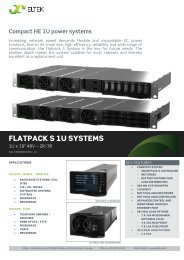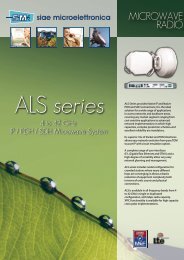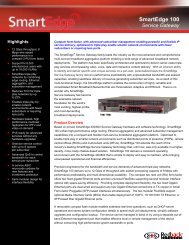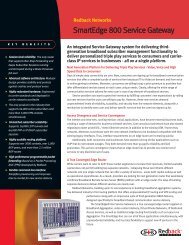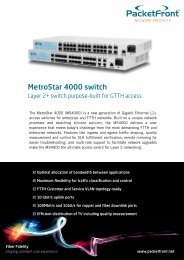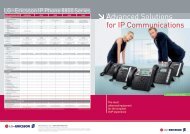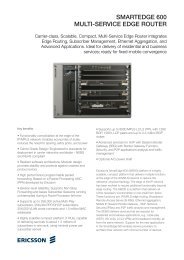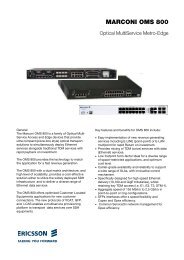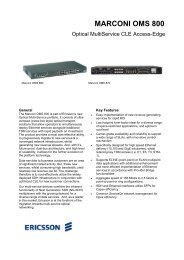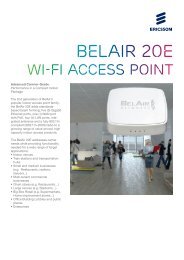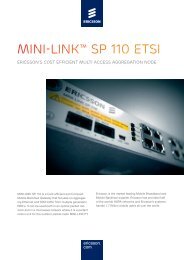VectaStar Gigabit ODU-S
VectaStar Gigabit ODU-S
VectaStar Gigabit ODU-S
You also want an ePaper? Increase the reach of your titles
YUMPU automatically turns print PDFs into web optimized ePapers that Google loves.
<strong>VectaStar</strong> <strong>Gigabit</strong> <strong>ODU</strong>-S<br />
System datasheet<br />
The <strong>VectaStar</strong> <strong>Gigabit</strong> <strong>ODU</strong>-S is a range of outdoor units for use as Access Points (APs) and Remote<br />
Terminals (RTs), which forms part of the wider family of Carrier Class <strong>VectaStar</strong> <strong>Gigabit</strong> point-to-multi-point<br />
products. <strong>ODU</strong>-S offers a compelling alternative to point to point, with up to 350 Mbps gross throughput per<br />
sector (2+0) and operating in the standard ETSI 10.5, 26 and 28 GHz frequency bands.<br />
<strong>ODU</strong>-S has a small form factor approximately 50% smaller and lighter than the prior generation of <strong>VectaStar</strong><br />
outdoor units, making <strong>ODU</strong>-S easier to install and maintain while providing logistics benefits for the operator.<br />
<strong>ODU</strong>-S 10.5 GHz systems are now offered with +23dBm of output power for increased range and they support<br />
28MHz channels which doubles capacity over prior <strong>VectaStar</strong> 10.5GHz solutions. <strong>ODU</strong>-S is equipped with a<br />
tilt sensor enabling the system software to report the polarisation setting of the APs and RTs to the VNMS<br />
management system. <strong>ODU</strong>-S employs a slip-fit waveguide antenna interface which supports vertical and<br />
horizontal polarization by simply rotating the <strong>ODU</strong>-S to suit the required polarization. No mechanical changes<br />
are required. A new range of <strong>ODU</strong>-S antennas include vertically and horizontally polarized 90 o sector horn<br />
antennas for APs and 30cm and 60cm parabolic antennas for RTs.<br />
<strong>VectaStar</strong> <strong>Gigabit</strong> <strong>ODU</strong>-S deployments can vary from single sector outdoor-only deployments to multi-sector<br />
protected radio hubs (1+1 and 2+0) with a Radio Controller (RC) providing aggregation and a single interface<br />
to the core network. Traffic from the network edge (e.g. NodeB, eNodeB, WiMAX BS, etc.) is backhauled by<br />
the connected RT to the sector AP. Within each sector, bandwidth is statistically multiplexed across multiple<br />
RTs in accordance with operator-defined QoS parameters. This dynamic allocation avoids the wasteful<br />
spectrum usage associated with PtP links. <strong>VectaStar</strong> systems support 7-state adaptive modulation for superior<br />
performance in all weather conditions.<br />
ACCESS POINT (AP-S)<br />
The <strong>VectaStar</strong> <strong>Gigabit</strong> <strong>ODU</strong>-S AP (AP-S) is an integrated radio,<br />
modem and network interface unit, connecting directly to a sector<br />
antenna. An AP-S can operate a single sector without any additional<br />
indoor equipment (Zero-footprint mode), backhauling traffic from up to<br />
8 RTs and terminating it on a single GigE interface. Up to 30 RTs per<br />
AP-S can be supported with the addition of the Radio Controller.<br />
Power and data are provided to the AP-S over a single CAT-5e cable<br />
or by 2-core cable for power and a single mode fibre for data.<br />
REMOTE TERMINAL (RT-S)<br />
The <strong>VectaStar</strong> <strong>Gigabit</strong> <strong>ODU</strong>-S RT (RT-S) offers class-leading full<br />
duplex throughput up to the available sector capacity of 175Mbps<br />
gross (150Mbps net Ethernet) in each direction (at 256QAM in a<br />
28MHz channel). Power and data are provided over a single CAT-5e<br />
cable. Alignment of the RT-S to the sector AP-S is performed using<br />
the dedicated alignment interface (BNC) and a standard voltmeter.<br />
SERVICES<br />
<strong>VectaStar</strong> <strong>Gigabit</strong> <strong>ODU</strong>-S supports Ethernet services. Support for<br />
TDM E1 services is provided via the use of a 1U indoor unit at the RT.<br />
At a multi-sector radio hub with RC, up to 126 E1’s can be terminated<br />
to the core over channelized STM-1 on a Multi- Protocol Aggregator<br />
(MPA). Up to 8 co-located E1s can be accommodated via an E1<br />
Concentrator.<br />
<strong>ODU</strong>-S AP-S & Sector Antenna<br />
<strong>ODU</strong>-S RT-S & 30cm Antenna
<strong>ODU</strong>-S TECHNICAL SPECIFICATIONS<br />
General 10.5 GHz 26 GHz 28 GHz<br />
Standards conformance ITU-R F.1568 & CEPT ERC 12.05E ITU-R F.748-4 Annex 1 & CEPT ERC 13.02E ITU-R F.748-4 Annex 2 & CEPT ERC 13.02E<br />
Duplexer Tx/Rx bands 10.15 – 10.3GHz / 10.5 – 10.65GHz 24.549 – 25.445GHz / 25.557 – 26.453GHz 27.5485 – 28.4445GHz / 28.5565 - 29.4525GHz<br />
Duplex spacing 350MHz 1008MHz<br />
Radio access method<br />
Single Carrier FDD Full Duplex, TDMA uplink and downlink<br />
Radio transmit power +23dBm +18dBm<br />
Channel sizes<br />
Modulation<br />
Latency (Typical)<br />
Synchronisation<br />
Sector throughput<br />
per Access Point<br />
7, 14 and 28 MHz<br />
Hitless Adaptive Modulation (ACM) and fixed mode, 7 states, QPSK up to 256QAM with Trellis Coding<br />
Average < 0.6ms with 99.9% < 1.0ms at



